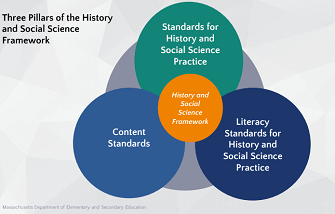How can we teach students the most vital skills to function as citizens? Since the early 19th century, preparation for civic life has been the central reason for public schools. As part of a multi-year effort to reinvigorate the civic mission of schools, in 2016 the Massachusetts Board of Elementary and Secondary Education (BESE) added “readiness for civic life” to its core definition of what it means to be educated in the state. http://www.doe.mass.edu/ccr/
In 2018, Massachusetts elementary teachers gained a major boost for efforts to integrate civics and social studies into the curriculum when the BESE built the new state History and Social Science (HSS) Curriculum Framework on a foundation of seven practice standards. To signal its intent, the board placed seven Standards for History and Social Science Practice, Pre-K to Grade 12 at the beginning of each grade and course of the new framework. These practice standards are grounded in research on effective instruction (National Research Council. 2005) and on national standards; and they lay out the essential steps for inquiry in HSS disciplines. Most important for K-5 teachers, both Massachusetts and national standards match completely with the state’s English Language Arts literacy standards.
Indeed, Massachusetts HSS practice standards 2-6 (of seven) directly trace their roots to specific ELA standards. (See pages 23-25 of the HSS framework.) For example, standard 2–“Develop focused questions or problem statements and conduct inquiries”–obviously emphasizes inquiry. Yet the language of Practice Standard 2 is even more explicit, making a direct correspondence to Massachusetts ELA writing standard 7. Meanwhile, practice standard 3 directly corresponds to ELA reading standards 1-3. And so on. Thus, elementary teachers can now argue correctly that teaching Civics and Social Studies addresses their key literacy goals.
Where History and the Social Sciences are missing from a school’s curriculum, teachers will need to substitute HSS content and models for some portion of existing literature or canned nonfiction. The National Research Council makes quite clear that students must encounter context for content as well as conceptual models in HSS. Many students–especially those who struggle in school–respond with enthusiasm to content that relates to issues around them, such current events, issues of fairness, and exploration of social relationships.
Since 2006, Emerging America has emphasized just the sort of content-rich, inquiry-based instruction called for by the 2018 Massachusetts HSS framework. We emphasize the vast and incredibly rich diversity of media and voices of the Library of Congress and other digital collections. Tools such as the Library of Congress Primary Source Analysis Tool, and the Primary Source Quadrant Analysis provide handy tools to help integrate primary sources and other rich content into basic literacy learning. Our Accessing Inquiry for Students with Disabilities through Primary Sources courses and website offer a wealth of strategies, exemplary lessons, and primary sources, to engage HSS content for literacy for diverse learners.
Citations:
National Research Council. 2005. How Students Learn: History in the Classroom. Washington, DC: The National Academies Press. https://doi.org/10.17226/11100.




